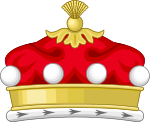John Maffey, 1st Baron Rugby
Sir Geoffrey Francis Archer | |
|---|---|
| Succeeded by | Sir George Stewart Symes |
| Personal details | |
| Born | John Loader Maffey 1 July 1877 |
| Died | 20 April 1969 (aged 91) |
| Spouse | Dorothy Gladys Huggins |
| Children | Alan Maffey, 2nd Baron Rugby Hon. Henry Maffey Penelope, Lady Aitken |
| Education | Rugby School Christ Church, Oxford |
| Occupation | Civil servant, diplomat |
John Loader Maffey, 1st Baron Rugby,
Biography
Early life
Maffey was the younger son of Thomas Maffey, a commercial traveller of Rugby, Warwickshire, and his wife, Mary Penelope, daughter of John Loader. He was educated at Rugby School and Christ Church, Oxford.
Career
He entered the
Representative to Ireland

On 14 September 1939, two weeks after the outbreak of
Chamberlain remarked that the title would "seem to be well suited to an appointment such as this which is essentially an emergency arrangement intended to meet a temporary but urgent situation".[5] After Maffey took up his appointment as "Representative", there were reports that the Irish Republican Army might abduct or kill him.[6]
Maffey held the post throughout the war years and until his retirement in 1949. During the war, he was undoubtedly the most important foreign diplomat resident in Dublin, given the complications of Ireland's neutrality policy. As "United Kingdom Representative to Eire", Maffey quickly established a good working relationship with Éamon de Valera. De Valera was personally in favour of the survival of democracy but did not necessarily trust the British to look after Ireland's best interests. Maffey was vital in mediating between the 'Warlord' Churchill and 'the Chief' de Valera.
When de Valera was replaced by a coalition, headed by John A. Costello, in 1948, Maffey again established a good working relationship with its members, but he was scathing about the clumsy manner in which the declaration of a Republic was handled: "Mr. Costello has handled the business in a slipshod and amateur fashion".
He encouraged
In his memorandum, "The Irish Question in 1945",
Maffey felt that "we can now talk to Eire on a cold, factual, horse-trading basis, knowing perfectly well that the cards are in our hands." He continued, "It must be admitted that, by ascribing Dominion status to Eire, we placed in unfriendly hands a power to weaken the conception and responsibilities of Dominion status. Eire has none of the attributes of a Dominion. She is a "Scotland " gone wrong, and we cannot afford to let her be completely divorced from the strategic and economic zone of England, Scotland and Wales." Turning to Northern Ireland, Maffey remarked, "Unhappily it is not possible for us to feel satisfied with the state of affairs in Northern Ireland. The Unionist Government are fighting an insidious enemy who is gaining upon them. Their ballot box is not safe over a period against the Catholic birth rate. The loyalty of the local garrison is not proof against the attractions of a lower income-tax rate in Eire. They are vulnerable to world criticism. The British Government cannot afford to ignore the pronouncement made in November 1944 by the Catholic Archbishop of Westminster, the Most Rev. Dr. Griffin, that there is religious persecution at the present day in Northern Ireland."
In February 1947, Maffey was raised to the peerage as Baron Rugby, of
His portrait hangs in the National Portrait Gallery of the United Kingdom. Painted by Philip de László in 1923, it was the study for two official portraits, at Government House, Peshawar, and Christ Church, Oxford.[8]
Family
Lord Rugby married Dorothy Gladys Huggins, daughter of Charles Lang Huggins, on 28 August 1907. They became the parents of three children: Alan, Henry, and Penelope.
Their only daughter, Penelope, married the war hero and Tory MP Sir William Aitken and became a well-known socialite. She was the mother of the former Conservative politician Jonathan Aitken and the actress Maria Aitken. Her grandchildren are the actor Jack Davenport, the artiste and environmentalist Alexandra Aitken (also known as Uttrang Kaur Khalsa), Victoria Aitken, and William Aitken.
Lord Rugby died in April 1969, aged 91. He was succeeded in the barony by his eldest son Alan Loader Maffey, 2nd Baron Rugby.
Popular culture
Maffey was played by Peter Copley in the 1983 RTÉ drama series Caught in a Free State.
He is a minor character in the 2010 novel Long Time Coming by Robert Goddard.
Arms
 
|
|
See also
- List of Ambassadors from the United Kingdom to Ireland
References
- ^ 'De Valera Rule 1932–75' by David McCullagh, Gill Books 2018 pg. 172
- ^ 'De Valera Rule 1932–75' by David McCullagh, Gill Books 2018, pg. 173
- ^ 'The Geopolitics of Anglo Irish Relations in the 20th Century'; GR Sloan; Leicester University Press 1997
- ^ 'De Valera Rule 1932–75' by David McCullagh, Gill Books 2018, pg. 174
- ^ No. 29 UCDA P150/2548 (Documents in Irish Foreign Policy)
- ^ No. 114 NAI DFA 2006/39 Confidential report from John W. Dulanty to Joseph P. Walshe (Dublin) (No. 6) (Secret) (Copy) London, 26 January 1940 (Documents in Irish Foreign Policy)
- ^ CP. (45) 152. 7 September 1945 entitled "Relations with Eire" being a Memorandum by the Secretary of State for Dominion Affairs" and exhibiting a Memorandum by Maffey entitled "The Irish Question in 1945" dated 21 August 1945
- ^ "NPG 6597; John Loader Maffey, 1st Baron Rugby". National Portrait Gallery (UK). Retrieved 17 November 2021.
- ^ Burke's Peerage. 1959.
- Oxbury, Harold. Great Britons: Twentieth-Century Lives. London: Promotional Reprint Company Ltd, 1993.
- Kidd, Charles, Williamson, David (editors). Debrett's Peerage and Baronetage (1990 edition). New York: St Martin's Press, 1990.

